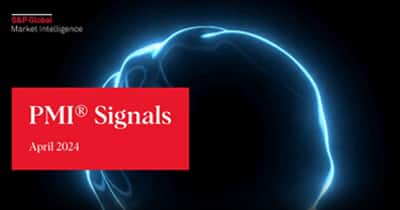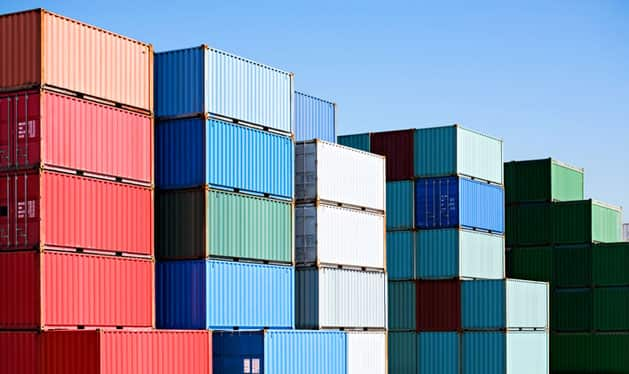Each national PMI dataset is compiled from questionnaire responses from a survey panel of senior purchasing executives (or similar) at around 400 companies. The survey panels are carefully recruited to accurately represent the true structure of the monitored sector: manufacturing, services, construction or the entire private sector economy.
The survey questionnaire covers the following economic variables:
Manufacturing
Output
New orders
New export orders
Backlogs of work
Output prices
Input prices
Suppliers’ delivery times
Stocks of finished goods
Quantity of purchases
Stocks of purchases
Employment
Future output | Services
Business activity
New business
New export business
Outstanding business
Prices charged
Input prices
Employment
Future activity | Whole Economy
Output
New orders
New export orders
Backlogs of work
Output prices
Overall input prices
Purchase prices
Staff costs
Suppliers’ delivery times
Quantity of purchases
Stocks of purchases
Employment
Future output | Construction
Total activity
Residential activity
Commercial activity
Civil engineering activity
New orders
Employment
Quantity of purchases
Suppliers’ delivery times
Input prices
Sub-contractor usage
Sub-contractor availability
Sub-contractor rates
Sub-contractor quality
Future activity
|
Questionnaires are completed in the second half of each month, and survey results are then processed by our economists. For each variable, panel members are asked to report an increase, decrease or no change compared with the previous month, and to provide reasons for any changes.
PMI indices are calculated as diffusion indices. For each variable, the index is the sum of the percentage of ‘higher’ responses and half the percentage of ‘no change’ responses. The indices vary between 0 and 100, with a reading above 50 indicating an overall increase compared to the previous month, and below 50 an overall decrease. The indices are then seasonally adjusted using an in-house method developed by S&P Global.
PMI indices are only available via subscription with the exception of a headline index. The headline index influences financial markets and receives considerable media coverage upon release. The headline index is calculated differently depending on the sector being monitored:
Manufacturing and Whole Economy
The headline figure is the Purchasing Managers’ Index™ (PMI). The PMI is a weighted average of the following five indices: New Orders (30%), Output (25%), Employment (20%), Suppliers’ Delivery Times (15%) and Stocks of Purchases (10%). For the PMI calculation the Suppliers’ Delivery Times Index is inverted so that it moves in a comparable direction to the other indices.
Services
The headline figure is the Services Business Activity Index. This is a diffusion index calculated from a question that asks for changes in the volume of business activity compared with one month previously. The Services Business Activity Index is comparable to the Manufacturing Output Index.
Construction
The headline figure is the Total Activity Index. This is a diffusion index that tracks changes in the total volume of construction activity compared with one month previously. The Total Activity Index is comparable to the Manufacturing Output Index and Services Business Activity Index.
Learn more about the PMI survey methodology.
PMI datasets are used by governments, financial institutions and corporates for forecasting, analysis and planning, helping to monitor key economic variables:
- GDP
- Manufacturing output / service sector output
- CPI/inflation indicators
- Producer input prices
- Exports and trade flow indices
- Employment/non-farm payrolls
- Productivity
- Profitability
- Factory/durable goods orders
- Backlogs of works/capacity indicators
- Supplier delivery times
- Inventory indicators
- Purchasing activity
PMI data are available for over 40 countries across a range of broad sectors:
Manufacturing
Australia
Austria
Brazil
Canada
China
Colombia
Czech Republic
France
Germany
Greece
India
Indonesia
Ireland
Italy
Japan
Malaysia
Myanmar
Mexico
Netherlands
Philippines
Poland
Russia
South Korea
Spain
Taiwan
Thailand
Turkey
United Kingdom
United States
Vietnam
GLOBAL
EUROZONE
ASEAN | Services
Australia
Brazil
China
France
Germany
India
Ireland
Italy
Japan
Russia
Spain
United Kingdom
United States
GLOBAL
EUROZONE | Whole Economy
Egypt*
Ghana
Hong Kong
Kenya
Lebanon
Mozambique
Nigeria
Qatar*
Saudi Arabia*
Singapore
South Africa
Uganda
United Arab Emirates*
Zambia
*Non-oil sector | Construction
France
Germany
Ireland
Italy
United Kingdom
EUROZONE |
In addition to providing national macroeconomic indicators, PMI data are also compiled for detailed sectors for a number of regions, allowing specific industry trends to be monitored:
| | Global | Europe | Asia | US |
| Basic Materials | • | • | • | • |
| Chemicals | • | • | • | |
| Resources | • | • | • | |
| Forestry & Paper Products | • | • | • | |
| Metals & Mining | • | • | • | |
| Consumer Goods | • | • | • | • |
| Automobiles & Auto Parts | • | • | • | |
| Beverages & Food | • | • | • | |
| Food | • | • | | |
| Beverages | • | • | | |
| Household & Personal Use Products | • | • | • | |
| Consumer Services | • | • | • | • |
| Media | • | • | | |
| Tourism & Recreation | • | • | | |
| Consumer Cyclicals | | | | • |
| Consumer Non-cyclicals | | | | • |
| Financials | • | • | • | • |
| Banks | • | • | • | |
| Insurance | • | | • | |
| Other Financials | • | • | | |
| Real Estate | • | • | • | |
| Healthcare | • | • | • | • |
| Healthcare Services | • | • | • | |
| Pharmaceuticals & Biotechnology | • | • | • | |
| Industrials | • | • | • | • |
| Industrial Goods | • | • | • | |
| Machinery & Equipment | • | • | • | |
| Construction Materials | • | • | • | |
| Industrial Services | • | • | • | |
| Commercial & Professional Services | • | • | • | |
| General Industrials | • | • | • | |
| Construction & Engineering | | • | | |
| Transportation | • | • | • | |
| Technology | • | • | • | • |
| Technology Equipment | • | • | • | |
| Software & Services | • | • | • | |
| Telecommunication Services | • | | | |

















